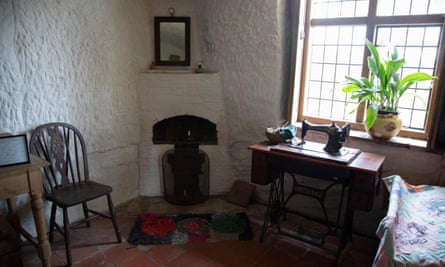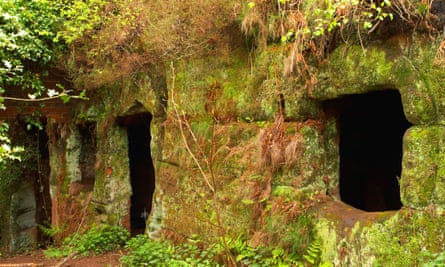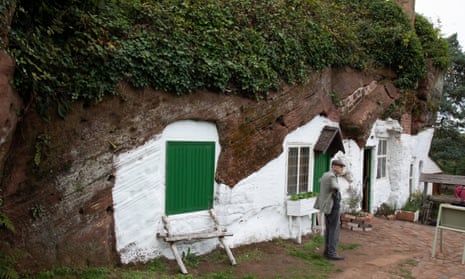As the morning sun breaks through the conifers at Kinver Edge, I pause for a moment to watch the light flood the forest floor. You’d never know from the roadside, but this woodland on the edge of the Black Country was home to England’s last troglodytes.
Four miles south-east of Stourbridge, on the Staffordshire-Worcestershire border, Kinver Edge is a 250-million-year-old sandstone escarpment with a network of cavernous houses carved into its three rocks – Holy Austin, Nanny’s and Vale’s – and an iron age hill fort. People lived here until they were persuaded to swap their caves for local council housing in the mid-1950s, leaving a 400-year legacy behind.
I follow a signposted route from the lay-by through the woods and towards the entrance, where a National Trust volunteer is checking tickets. Today Kinver Edge is an attraction rather than a community and its star is Holy Austin Rock, a 164-metre-tall sandstone ridge with two restored cottages and a cafe.
Inside the entrance is a meadow of grass and wildflowers, ahead of me an orchard of apple and pear trees, whose fruits the Kinver cave dwellers made into jam. Further on, peas, pumpkins and cabbages are growing on a little hillside allotment similar to the one created hundreds of years ago by the farm labourers, hawkers and gamekeepers who lived here self-sufficiently.

These cave people led comparatively comfortable lives, away from society and surrounded by nature: their water came from the deepest private well in Britain and the easy-to-carve sandstone made house renovations simple. It’s thought that Kinver Edge’s first inhabitants stumbled on it in the early 17th century, though official records date from 1777. “We believe quarry workers arrived in the early 1600s and were the first people to excavate,” says NT visitor experience manager Helen Selkirk. “We think they were initially just looking for temporary shelter after quarrying. The rock was easy to carve and as they could extend rooms quickly, some of them ended up living here permanently,” she adds. “Carving the rock houses was probably more out of convenience than a necessity.”
By 1860, 44 people were living across 11 houses at Holy Austin. Word got out about this Black Country beauty spot, and from 1901 a new light railway – Britain’s first cross-country tramway – ushered visitors into an area that was being trumpeted as the “Switzerland of the Midlands”. Entrepreneurial troglodytes set up a tearoom to serve the daytrippers, who saw Kinver Edge as a sanctuary from the sooty-skied, industrial heartland of the Black Country to enjoy countryside walks, family picnics, teas and fresh air until the rail service was discontinued in 1930.
I also feel a world away from the city, and carry on through the orchard and past the allotment. Straight ahead, Fletcher’s Cottage, with its bright-white facade and terrace herb garden is as enticing as I imagine it was in its pomp. The cottage has been meticulously restored based on an early 1900s Alfred Rushton painting of former residents Mr and Mrs Fletcher.
Inside Fletcher’s Cottage a large fire dominates the main living area, where there’s also a dining table, bathtub and some traditional toys. Round the corner, Martindale Rock House was recreated from a 1930s photograph, with a dark oak larder unit, cooking utensils and a small bedroom to the side.

Up some steps on the middle level is a row of hollowed out caves. In stark contrast with Fletcher’s and Martindale, these rock houses have no facilities and are not cottage-like whatsoever. They were a place to sleep and keep dry after a long day at work. The views probably helped.
On the upper level is another series of open caves with floor-to-ceiling inscriptions throughout, though I suspect that some are more recent than others. The Rock House cafe, which served tourists until its 1964 closure, is here in a new guise, serving hot drinks, homemade sandwiches, soups and, appropriately, rock cakes. Just like the tourists in 1901, I have a cup of tea and enjoy the view. Then I follow the uphill trail to the iron age hillfort. I dodge the cowpats left by grazing longhorn cows to reach the summit. From here I can see the Malvern Hills to the south-west, and the Cotswolds to the south. It’s impressive – if not quite Switzerland.
